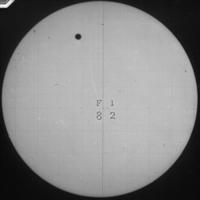Transit Computer
This data service calculates the circumstances of selected
transits
of Mercury and Venus. Use the following
steps to determine the circumstances for any location.
- Select the transit of interest from the drop-down list.
- Specify the location of interest using the fields provided
on the form. Use the buttons
to find coordinates of cities or towns in the U.S. or its territories,
or to convert between Degrees-Minutes-Seconds (DMS) and Decimal Degrees.
- Click the "Get Data" button at the end of the form to compute a
table of local circumstances.
Be sure to read the
Notes
on the Data
for an explanation of the items in the table.
For additional information on transit circumstances and visibility, see
Upcoming and Recent Transits
of Mercury and Venus.
Notes

This service provides local circumstances for transits of Mercury and Venus. For a selected
transit, up to five phases of the transit are listed in the tabular output: Transit
Begins (Ingress Exterior Contact), Ingress Interior Contact, Least Angular Distance, Egress Interior Contact,
and Transit Ends (Egress Exterior Contact). Depending upon the location, all, some, or none
of phases are observable. The times at which these phases occur are given
on a 24-hour clock (e.g. 13:00 = 1:00 p.m., etc.) in Universal Time.
Use our table for locations in the United States or the
world time zone map to convert from Universal Time to
local time. If the transit is in progress when the Sun rises or sets, the time of sunrise or sunset
may also appear in the table. The position angle of the contact points are reckoned from
the north point of the limb of the Sun towards the east. Also included in the tabulation are the
altitude
(uncorrected for
refraction
) and
azimuth
of the
center of the Sun's disk, in degrees, as well as the angular separation of the center of
Mercury or Venus and the center of the Sun, in arcminutes (there are 60 arcminutes in a degree).
The semidiameter -- the angle at the specified location subtended by the radius of the
object -- of the Sun, Mercury, and Venus is tabulated in arcminutes (') and arcseconds (").
Transit of Venus photographic plate (1882) image courtesy of the
U.S. Naval Observatory Library
.
For additional information, see:

